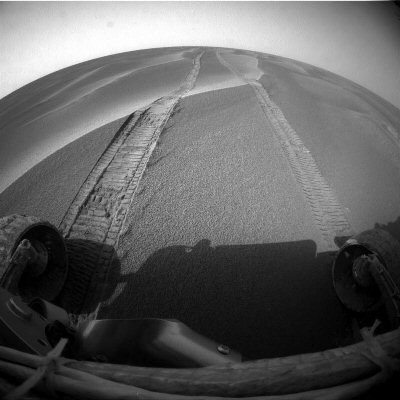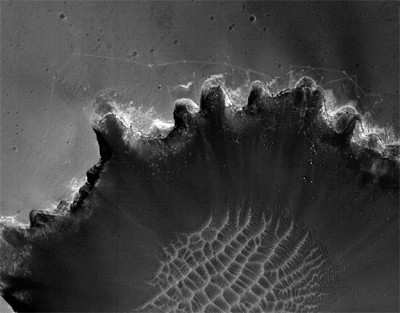Sat, Aug 30, 2008
Erstwhile Rover Back On Flat Ground
NASA announced Friday its Mars Exploration Rover Opportunity has
climbed out of the large crater that it had been examining from the
inside since last September.

"The rover is back on flat ground," an engineer who drives it,
Paolo Bellutta of NASA's Jet Propulsion Laboratory, announced to
the mission's international team of scientists and engineers.
Opportunity used its own entry tracks from nearly a year ago as
the path for a drive of 6.8 meters (22 feet) bringing the rover out
over the top of the inner slope and through a sand ripple at the
lip of Victoria Crater. The exit drive, conducted late Thursday,
completed a series of drives covering 50 meters (164 feet) since
the rover team decided about a month ago that it had completed its
scientific investigations inside the crater.

"We're headed to the next adventure out on the plains of
Meridiani," said JPL's John Callas, project manager for Opportunity
and its twin Mars rover, Spirit. "We safely got into the crater, we
completed our exploration there, and we safely got out. We were
concerned that any wheel failure on our aging rover could have left
us trapped inside the crater."
The Opportunity mission has focused on Victoria Crater for more
than half of the 55 months since the rover landed in the Meridiani
Planum region of equatorial Mars. The crater spans about 800 meters
(half a mile) in diameter and reveals rock layers that hold clues
to environmental conditions of the area through an extended period
when the rocks were formed and altered.
The team selected Victoria as the next major destination after
Opportunity exited smaller Endurance Crater in late 2004. The
ensuing 22-month traverse to Victoria included stopping for studies
along the route and escaping from a sand trap. The rover first
reached the rim of Victoria in September 2007. For nearly a year,
it then explored partway around the rim, checking for the best
entry route and examining from above the rock layers exposed in a
series of promontories that punctuate the crater perimeter.

Now that Opportunity has finished exploring Victoria Crater and
returned to the surrounding plain, the rover team plans to use
tools on the robotic arm in coming months to examine an assortment
of cobbles -- rocks about fist-size and larger -- that may have
been thrown from impacts that dug craters too distant for
Opportunity to reach.
More News
The Industry Continues to be Rocked By Some Questionable Operations Recent investigations and a great deal of data has resulted in ANN’s SportPlane Resource Guide’s rep>[...]
Make Sure You NEVER Miss A New Story From Aero-News Network Do you ever feel like you never see posts from a certain person or page on Facebook or Instagram? Here’s how you c>[...]
Visual Approach Slope Indicator (VASI) An airport lighting facility providing vertical visual approach slope guidance to aircraft during approach to landing by radiating a directio>[...]
Airport Marking Aids Markings used on runway and taxiway surfaces to identify a specific runway, a runway threshold, a centerline, a hold line, etc. A runway should be marked in ac>[...]
Aero Linx: The Skyhawk Association The Skyhawk Association is a non-profit organization founded by former Skyhawk Pilots which is open to anyone with an affinity for the A-4 Skyhaw>[...]
 Unfortunate... ANN/SportPlane Resource Guide Adds To Cautionary Advisories
Unfortunate... ANN/SportPlane Resource Guide Adds To Cautionary Advisories ANN FAQ: Turn On Post Notifications
ANN FAQ: Turn On Post Notifications ANN's Daily Aero-Term (04.29.24): Visual Approach Slope Indicator (VASI)
ANN's Daily Aero-Term (04.29.24): Visual Approach Slope Indicator (VASI) ANN's Daily Aero-Term (04.28.24): Airport Marking Aids
ANN's Daily Aero-Term (04.28.24): Airport Marking Aids ANN's Daily Aero-Linx (04.28.24)
ANN's Daily Aero-Linx (04.28.24)




